In this session, Professor Wing Ho will introduce some viola exercises for beginners.
Content of Wing Ho’s lecture is as follows (edited in first person):
Good evening, everyone. In today’s session, I will share some pictures, which can help you understand the details better.
Let’s start from scales. Practicing scales can be a headache to viola players, especially young learners. They do not like to play scales. In fact, every piece contains scales and arpeggios. We are supposed to find the joy of learning scales. Also, we need to find the similarities and differences among all types of scales. Then we can play scales more easily. I would like to make an analysis of scales and arpeggios in this session to help you understand them better.
Scale Systems Which Are Frequently Used
Carl Flesch’s Scale System
There are 3 scale systems which are most important, among which the most frequently used in China is Carl Flesch’s scale system. Many viola players are familiar with Carl Flesch’s scale system, because most of them started to play his scales at a young age.
Carl Flesch was a famous music educator from Hungary. He started to learn the violin at the age of 5. During his lifetime, he taught in many countries including France, Switzerland, Austria, and the UK. He even taught in Curtis Institute of Music in the US. The educator left us in 1944. In the next year, one of his students created the Carl Flesch International Violin Competition. The competition was held every 2 years. In 1970, viola was also included in the competition.
Carl Flesch wrote some classic books in his lifetime, such as Basic Studies for Violin, Problems of Tone Productions in Violin Playing, and The Art of Violin Playing. The three books are like bibles for violin teachers. Besides, the educator’s Scale System for Violin is the most well-known one. It was first published in 1926. Also, there is another book called Studies and Exercises for Violin.
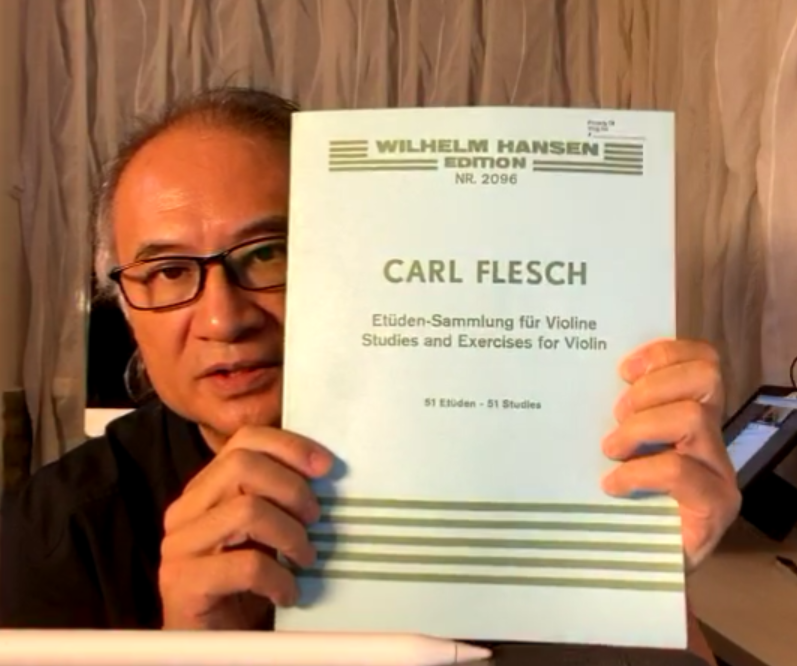
This book contains 50 etudes written by many famous composers, such as Kayser, Mazas, and Kreutzer. The etudes were carefully selected. Almost all violin techniques were included. What’s more, there are 24 scales contained in the book. The most important contribution it made to the practice of scales is that it used the system of 7 arpeggios. Most of us are familiar with this system. Also, the exercises of third sequences, chromatic scales, single-string scales, double stops, thirds, octaves, tenths, and harmonics are included in the book. In addition, 21 notes are contained in every descending scale and ascending scale.
Ivan Galamian’s Scale System
Ivan Galamian was born in 1903 and died in 1981. During his lifetime, he taught many famous violinists, including Perlman and Zukerman. He also wrote some classic books, which are widely used by scholars and violinists.
One of the most well-known books written by Galamian is Principles of Violin Playing & Teaching. This book is very comprehensive that many teachers regard it as the bible of teaching. Chinese teachers may not be familiar with the author’s The Galamian Scale System (adapted for viola by Karen Olson). But in the United States, Galamian’s scale system is used by almost all music conservatories. In this system, 24 notes are contained in every descending scale and ascending scale. The notes can be put in different orders. Later, I will share a picture showing the orders.
When we play Carl Flesch’s scales, we get to know from the sheet music that the fingering above the first note and that below the first note are different. The fingering above the first note means that we need to play the note with the middle finger, while the fingering below the first note means that we should play with the index finger.

Different players may have different habits. But generally speaking, we tend to play the first note with the middle finger in order to play more comfortably. Starting to play with the index finger may cause discomfort in some way.
When we play Galamian’s scales, we tend to start to play with the index finger. Compared to Carl Flesch’s scales, there are more notes contained in Galamian’s scales. We can put the notes in different orders while practicing. Besides, the system of 10 arpeggios is used. Players may find it uncomfortable to play the arpeggios at the beginning, but the system of 10 arpeggios can be really helpful to viola players. This system is widely used in music conservatories in the US.
Compared to the system of 7 arpeggios, the system of 10 arpeggios requires us to do much more exercises, such as the exercises of thirds, fourths, fifths, sixths, and so on. There are 24 major and minor scales contained in Carl Flesch’s scale system, and each of the keys is clearly marked. But when it comes to scales in Galamian’s scale system, we can only see some certain fingerings on the sheet music. Actually, if we have already practiced the chromatic scales and sequences in Galamian’s scale system, we will find out the regularities. This scale system is useful to all viola players.
Jan Hřímalý’s Scale System
Jan Hřímalý’s scale system can be regarded as the earliest scale system. Most of us are familiar with this scale system as well.
Hřímalý’s Scale-Studies for the Violin was first published in 1905. The author was born in 1855 and died in 1915. There are 24 notes contained in every descending scale and ascending scale. The fingerings of Hřímalý’s scales are similar to that of Carl Flesch’s scales.
Hřímalý’s scale system is also frequently used in China. In Hřímalý’s scales, the system of 2 arpeggios is used. Since the number of arpeggios is small, we tend to combine Hřímalý’s scales and Carl Flesch’s arpeggios together. Likewise, we usually start to play Hřímalý’s scales with the middle finger. We can also start with the index finger, but starting with the middle finger is recommended. Here I would like to share a picture:
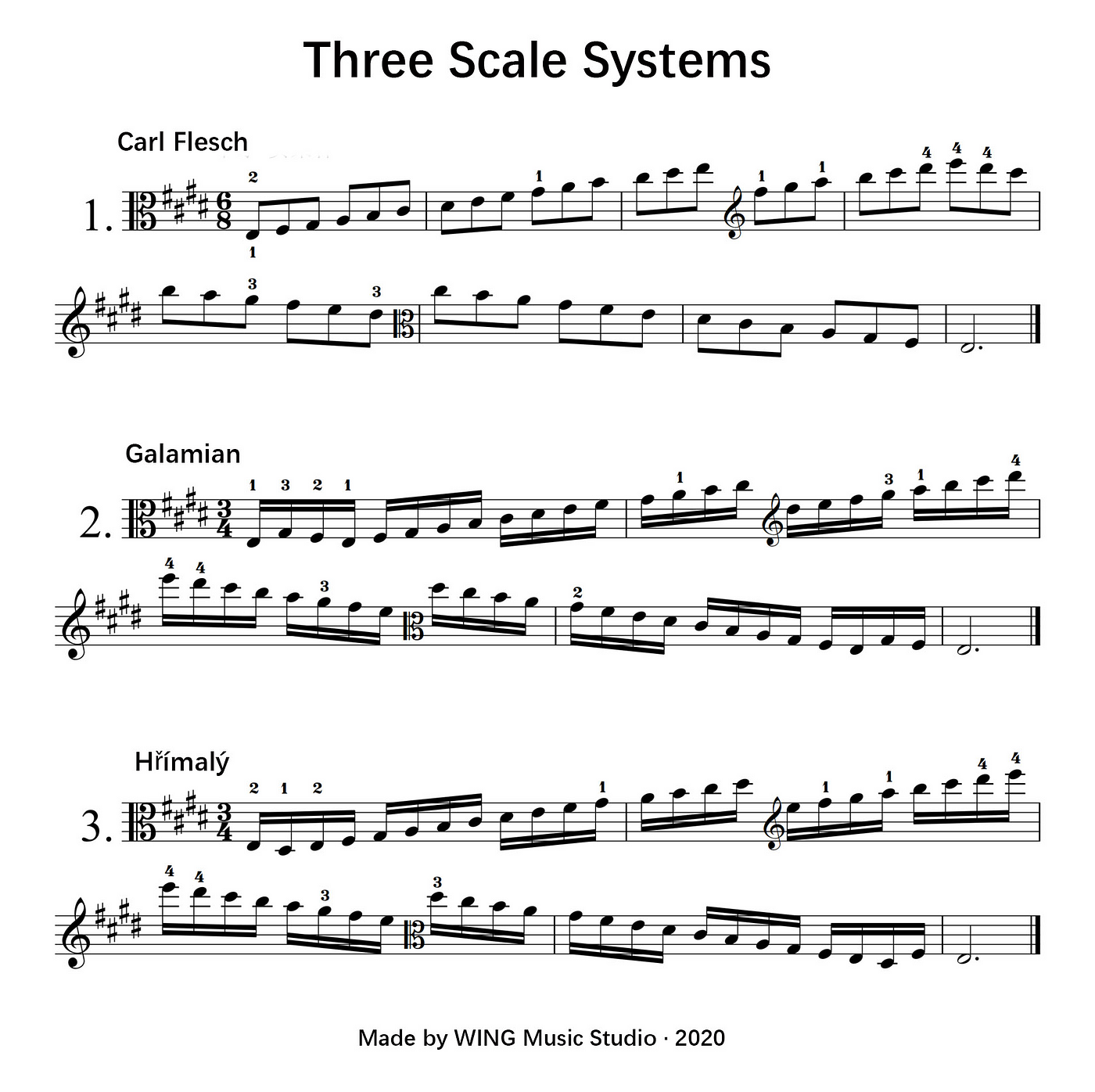
We can see from the picture that triplets are used in Carl Flesch’s scale. There are 21 notes contained in every descending and ascending scale (the last note is not counted). Here I would like to make a demonstration. To make it easier to understand, I will use the key of E major. We tend to use B major when playing the scales on the violin. The fingerings will not change.
The notes in Carl Flesch’s scales cannot be put in many different orders. During the exams, students may choose to play the notes included in the scales on 2, 3, or 4 bow strokes. The number of bow strokes is not fixed, but we should pay attention to the speed of playing.
Now let’s take a look at Hřímalý’s scale. The last note of the ascending scale and the first note of the descending scale are the same.
The fingerings of Carl Flesch’s scales are similar to that of Hřímalý’s scales, but Carl Flesch only used triplets in his scales. Since Hřímalý’s scales contain more notes, we can put the notes in more orders. I will share a picture showing the details then. Besides, we can play Hřímalý’s scales at different tempos.
Now let’s have a look at Galamian’s scale. We need to start to play the scale with the index finger, and the fingerings are different from that of the other 2 masters’ scales. Also, the last note of the ascending scale and the first note of the descending scale are different.
Intervals and Fingerings Need to Be Paid Attention to
Intervals and Fingerings of Scales
When we are practicing ascending scales, we can use either major seconds or minor seconds while changing the positions.
When we are practicing descending scales, we need to use minor seconds while changing the positions, which can make it easier for us to avoid unneeded movements, and improve the intonation. If we use major seconds while changing the positions, the intonation is not likely to be good.
As for the fingerings of the scales, the last 2 notes in the ascending scales are played with the little finger. Since the pitches of the last 2 notes are high, it is difficult to play the notes with the other fingers. Also, the intonation may not be good if we play the notes with other fingers.
Some students tend to play the last 2 notes with the ring finger and little finger respectively, but I do not recommend players to play in this way. When we are playing in higher positions, it is pretty hard to play with both the ring finger and the little finger. Playing the notes with the little finger can be easier.
All three masters used the same fingerings when it comes to the last 2 notes in the ascending scales. We should pay attention to the fingerings as well.
We can notice that the first 2 notes in Galamian’s ascending scale are played with the index finger and the ring finger respectively. It may be a little bit difficult for young learners. Galamian used other fingerings in his scales as well, such as playing all notes with the index finger, playing with the index finger and the middle finger alternatively, playing with the index finger, the middle finger, and the ring finger in turns, and playing with the four fingers in rotation. Different fingerings can be beneficial to us when practicing scales.
Intervals and Fingerings of Arpeggios
When we are practicing scales, the most important intervals need to be paid attention to are minor seconds and major seconds. When we are practicing arpeggios, we should pay attention to minor thirds, major thirds, and perfect fourths. Knowing intervals can help us change the positions more accurately.
When it comes to arpeggios, there are mainly 3 types of fingerings, which were frequently used by the 3 masters mentioned above. Among the 3 types, there are 2 types of fingerings which are commonly used when playing the violin. For the violas, these 2 types can also be used if our instruments are not too big. If we use the other 1 type on the viola, we are likely to play more comfortably, but the intonation may be affected. Here I would like to share a picture showing the fingerings of arpeggios:
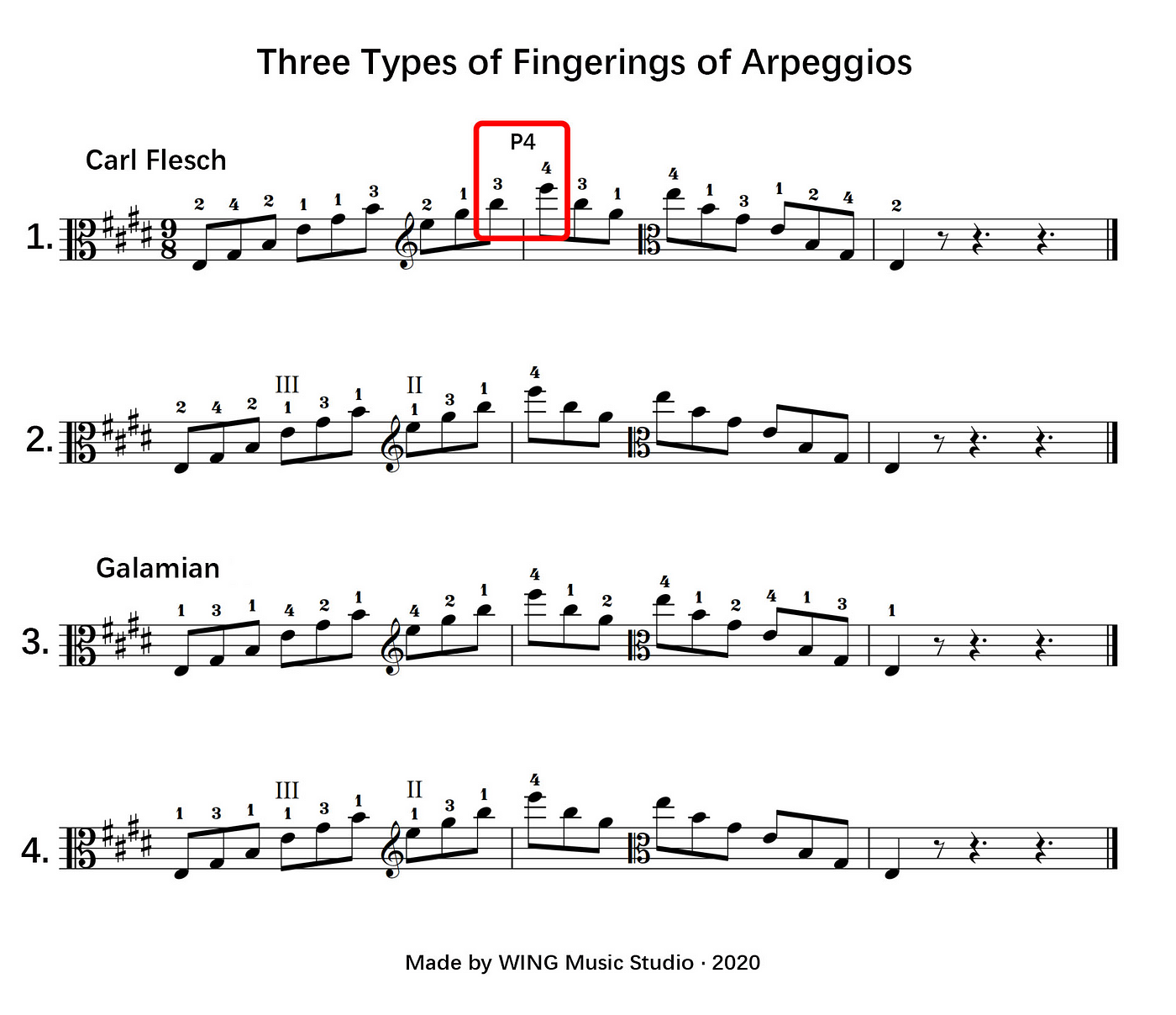
Let’s take a look at fingerings of the first arpeggio (marked “1.” in the picture). We need to start to play with the middle finger. Carl Flesch’s arpeggios in the picture above are in E major. We can play very comfortably using the fingerings showed above. We may need to stretch the ring finger and the little finger a little bit when playing the last 2 notes in the ascending arpeggio(as marked in the picture), since there is a perfect fourth.
Then let’s have a look at the third arpeggio(marked “3.” in the picture). We need to start to play with the index finger. We may find it more comfortable to play the arpeggio on the viola if we use Galamian’s fingerings. We do not have to stretch the fingers while playing.
When we play the second and fourth arpeggios(marked “2.” and “4.” in the picture), we should combine the fingerings and positions. The 2 arpeggios are useful for the training of changing the positions, and we need to make sure that the intonation is not affected while playing. The tonic is not likely to be played correctly at the beginning.
Since there are 24 major and minor keys, Carl Flesch wrote 24 major and minor scales. We may get confused in some way since there are too many scales. Galamian also wrote 24 individual major and minor scales, but he combined major and minor arpeggios together, which is to say, there are only 12 arpeggios. The notation is slightly different, but the fingerings are the same.
There are mainly 3 types of fingerings used in Carl Flesch’s scales, including starting to play on the open string, starting to play with the index finger, and starting to play with the middle finger.
If we start to play on the open string, we tend to start with G string on the violin, and C string on the viola.
If we start to play with the middle finger, we tend to start with A natural on the violin, and D natural on the viola.
Mastering the 3 types of fingerings mentioned above, we will find it easier to play scales. We just need to start from different positions while playing. The fingerings are also used in arpeggios. If we are familiar with the fingerings, we will notice that arpeggios are not difficult to play.
I hope all students can get to know more about scales and the 3 scale systems from the content I shared above.

Viola Exercises for Beginners
There is some important literature on viola practice, like Tartini’s The Art of Bowing for the Violin. There are a variety of exercises contained in this useful book.
Also, I would like to recommend Otakar Ševčík’s books. Otakar Ševčík was from Czechia. He wrote 10 books containing all exercises. There are 4 books included in Opus 1, which introduce the training of the left hand, such as using different fingerings and playing in different positions. In Opus 2, there are 2 books which include the bowing techniques. There are also 2 books contained in Opus 7, which contain the exercises of playing trills. What’s more, the Opus 8 introduces the training of changing the positions, while the Opus 9 contains the exercises of playing double stops. The 10 books are not difficult to find, and the viola versions of the books were already published.
Hans Sitt’s 100 Viola Etudes are also important for viola beginners. There are 5 books, and each book contains 20 viola etudes. The first book includes the exercises of playing on the first position, and the second book contains the exercises of playing on the second, third, fourth, and fifth positions. The third book introduces the exercises of changing the positions. As for the fourth book, the exercises of playing on the sixth and seventh positions are included. The fifth book contains the exercises of playing double stops.
The books I recommended above are all classic viola books. Every viola player can get improved by practicing the pieces included in the books.
Rhythm Practice
For rhythm practice, I would like to recommend this book called Accuracy in Rhythm.
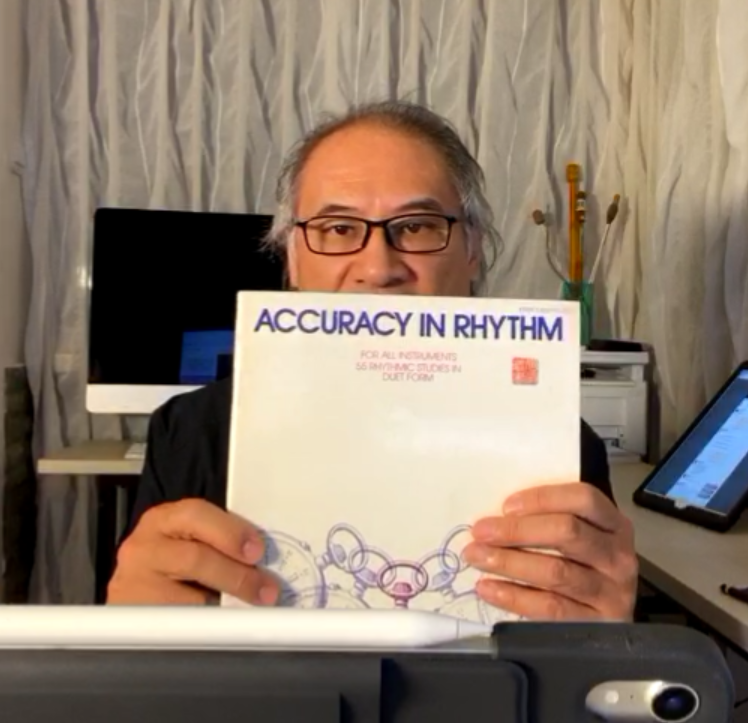
There is no clef contained in the sheet music in this book, which is to say, players of all string instruments including violin, viola, cello, and double bass can practice the pieces in different keys. Also, teachers and students can play together if there are two parts in the piece. Or students can clap to the beats of one part, and tap to the beats of the other part at the same time. Young learners can definitely improve their rhythm if they practice in this way.
In this book, there are over 50 pieces covering almost all problems related to rhythms.
in China, there are few resources for the viola. Today in this session, I gave a thorough introduction of original viola books. Students can find the books online easily.
As for the rhythms of scales and arpeggios, I would like to share a picture here:
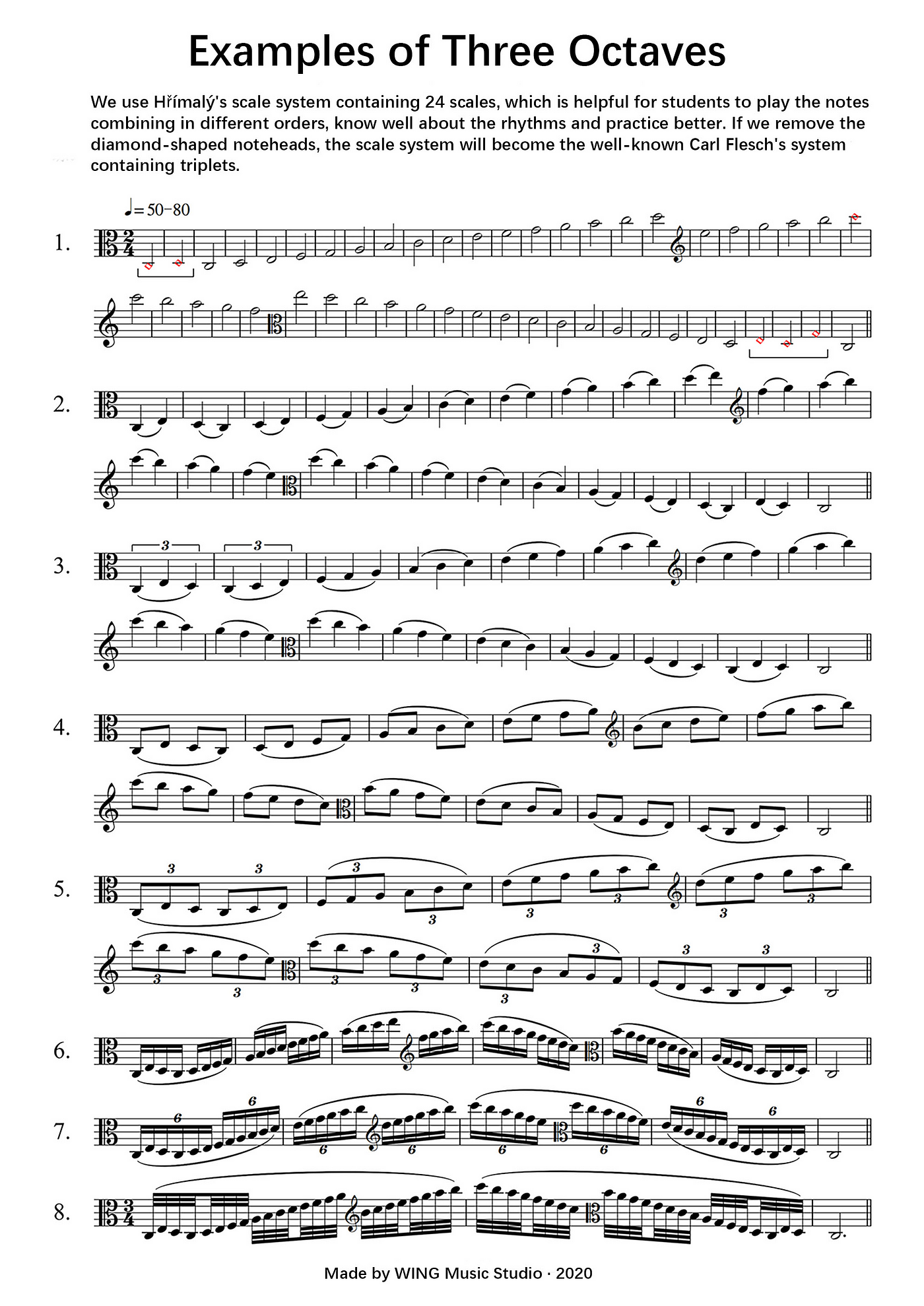
When we are practicing, we can play a certain rhythm slowly at first, and gradually speed up. This way is very helpful. Since there are 24 scales, the notes can be put in different orders. All my students practice the rhythms in this way. Other young learners can try it as well. Children can start from playing 4 or 6 notes on a bow stroke, and gradually speed up to play all 24 notes on 1 bow stroke.
I recommend all viola players to use metronome while practicing the rhythms. Metronome is a useful tool.
Viola Etudes
Generally speaking, there are 14 etude books which are frequently used, among which half of them contain violin etudes, and the other ones contain viola etudes. The viola etudes may not be very basic. The books are helpful for all players.
Wohlfahrt’s 60 Studies for the Violin, Op.45 is the most popular etude book in China. In this book, the first 30 etudes are played on the first position, while the other 30 ones are played on the third and higher positions.The author also wrote 70 Easy Melodious Studies for the Violin, Op. 74. and 40 Elementary Studies for Violin, Op. 54. Compared to the Op. 45, the Op. 74 and Op. 54 are easier. If students can find the books, they can try to practice the etudes included.
Kreutzer, Fiorillo, Mazas, and Rode were composers who wrote early etudes, which are not easy to play. Kayser, Wohlfahrt, and Dont were composers who died in the 1880s. They simplified their etudes, and the etudes tend to be easier than the early ones.
Actually, the etudes were written for the viola instead of the violin at the beginning. There are other composers earlier than Kreutzer and his contemporaries who wrote viola etudes, such as Hoffmeister, Bruni, and Campagnoli. Hoffmeister wrote 12 melodious etudes. Bruni wrote both viola etudes and violin etudes, which are not long or difficult, but very useful. Campagnoli’s etudes are a little difficult to play.
Besides, there are composers who died in the 20th century, and wrote etudes in their lifetime, such as Vieux from France, Lukács from Hungary, and Fuchs from the US. These composers’ etudes contain techniques which are helpful for playing modern works.
Fuchs was a female composer and teacher in Curtis Institute Of Music who wrote two etude books. Her etudes are suitable for viola playing. Fuchs’ daughter plays the cello, and her granddaughter plays the viola. Her granddaughter made two albums containing Fuchs’ etudes. Students can find the albums online.
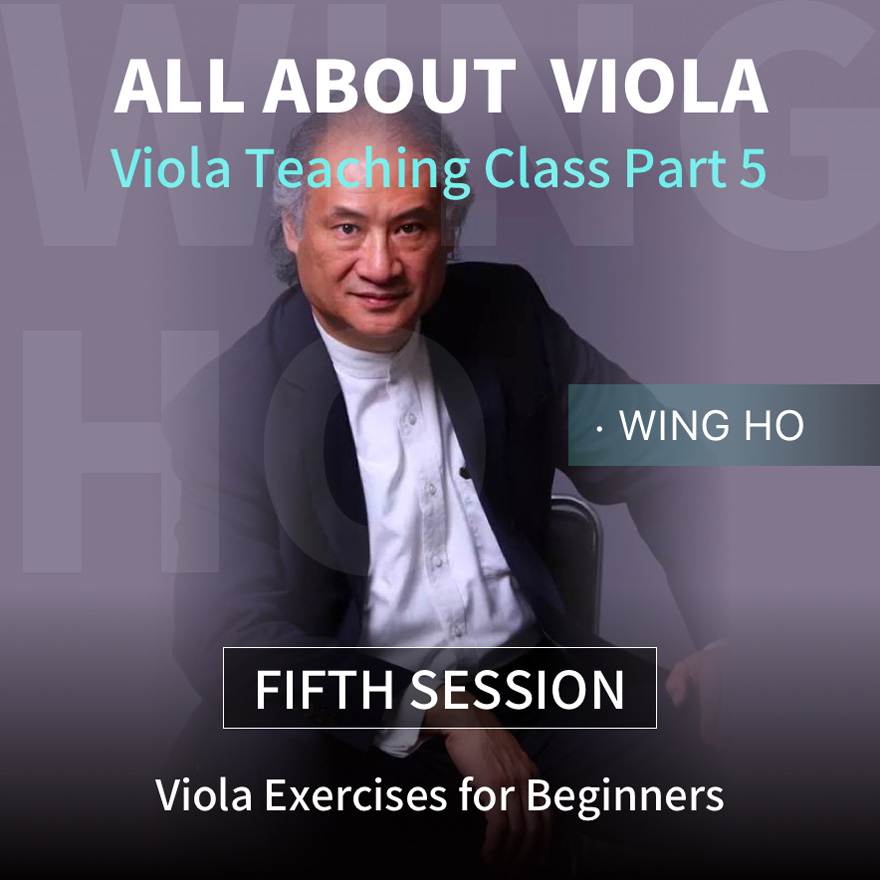
Here I would like to make a list of the frequently used etude books:
Wohlfahrt: 60 Studies for the Violin, Op.45
Wohlfahrt: 40 Elementary Studies for Violin, Op. 54
Wohlfahrt: 70 Easy Melodious Studies for the Violin, Op. 74
Palaschko: 10 Viola Studies, Op. 49
Kayser: 36 Elementary and Progressive Studies for the Viola, Op. 20
Fiorillo: 36 Etudes or Caprices for Violin Solo
Dont: 24 Etudes and Caprices for Violin Solo, Op. 35
Dont: 24 Exercises for the Violin, Op. 37
Mazas: Etudes Speciales for Viola, Op. 36
Kreutzer: 42 Studies for Viola
Paganini: 24 Caprices for Solo Violin
Bruni: 24 Studies for Viola
Hoffmeister: 12 Etudes for Viola
Fuchs: 15 Characteristic Studies for Viola
Fuchs: 16 Fantasy Etudes for Viola
Lukács: Exercises in Change of Position for Viola, Advanced Grade
Campagnoli: 41 Caprices for Viola, Op. 22
Vieux: 20 Etudes for Viola
Vieux: 10 Etudes sur les Intervalles for Viola Solo
Most viola etudes are melodious and not very easy to play. The etudes are like opuscula, which can be performed on stage. 10 Viola Studies, Op. 49, written by Palaschko, are frequently played in China. Actually, Palaschko wrote several etude books, but the Op. 49 is the most popular one.
What’s more, few players practice Vieux’s 20 Etudes for Viola since the etudes are too difficult. The pieces are even more difficult than Paganini’s 24 caprices. 10 Etudes sur les Intervalles for Viola Solo, another book written by Vieux, is helpful for viola players to know better about the intervals.
That’s all for my session today. The scale systems I introduced above are worth studying. Knowing more can help us understand the importance of practicing scales.
In fact, there has been music pedagogy since the Classical period in Western countries. But in China, there is no systematic music pedagogy. This is a significant reason why Chinese instruments are not internationally known. Therefore, young viola teachers can do more research, and write more papers on the topic of music pedagogy.
Music Q & A:
Audience: How to practice dotted notes?
Wing Ho: You may find the answer in Accuracy in Rhythm, the book I recommended above. The book is really useful for viola players.
Audience: How to practice scales together with etudes?
Wing Ho: Scales and etudes are different. Actually, we can practice scales and etudes separately.
When we are playing scales, we may focus on one or more octaves. Also, we need to consider the keys. Sometimes we practice the bowing skills by playing etudes, and in the meanwhile, we may not pay much attention to the keys.
Etudes can be very helpful if we need to improve the techniques, while scales can help us improve the intonation, the rhythm, and the speed of playing. We don’t have to practice etudes and scales together.
Audience: How to play descending scales smoothly?
Wing Ho: I recommend you to keep your index finger on the string while playing scales. The index finger can play a role of leading the movements of other fingers.
Have a HAPPY practice!!
All About Viola - Viola Teaching Class
All about Viola 1 | Tips about Enlightenment Teaching of Viola
All about Viola 2 | Basic Teaching of Viola
All about Viola 3 | Viola Bowing Techniques
All about Viola 4 | Movements of the Left Hand
All about Viola 5 | Viola Exercises for Beginners
All about Viola 6 | Common Viola Repertoire Catalog
All about Viola 7-8 | Music Learning and Career Choice
More Violy Master Class Articles:
Cello Master Class - Wu Linfeng
Violin Master Class - Wang Boyang
Violin Master Class - Gu YingLong
#ViolyPractice makes Perfect!!
Follow us on: Violy.app
